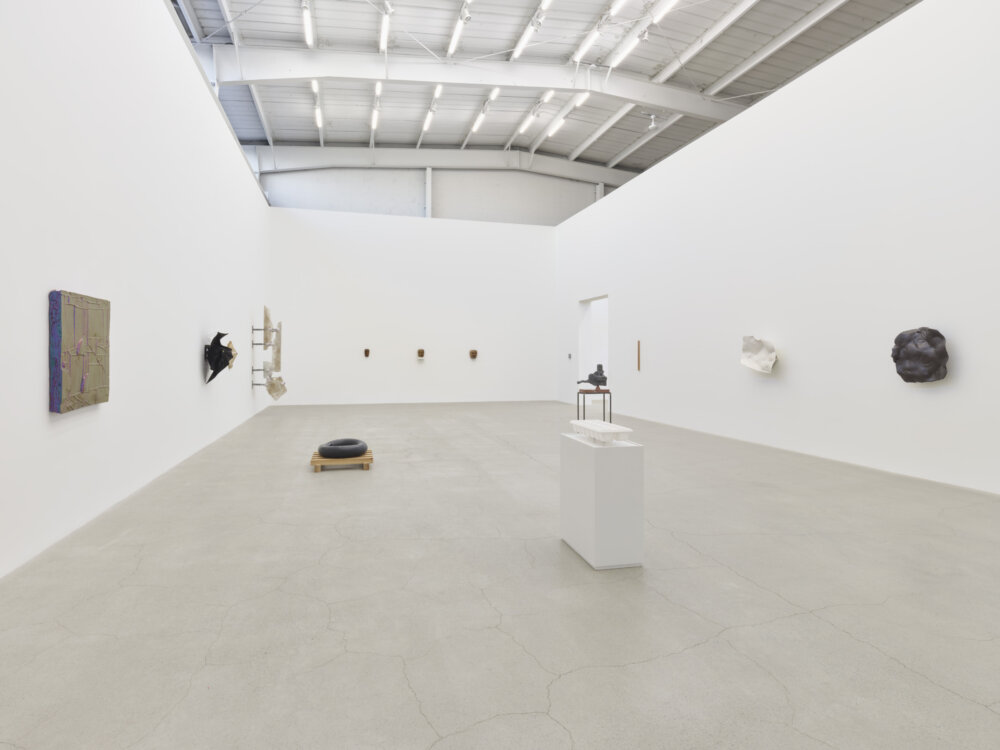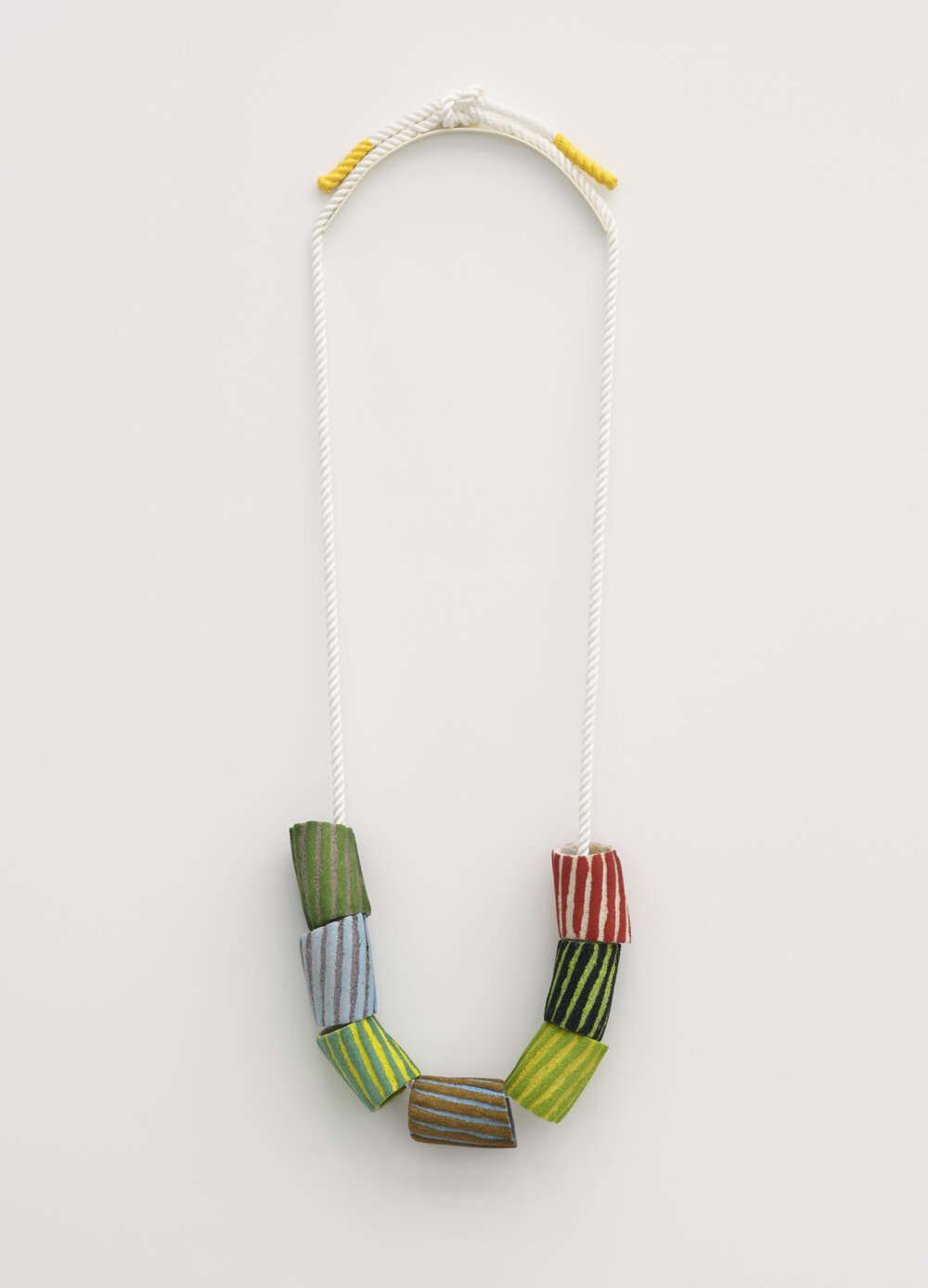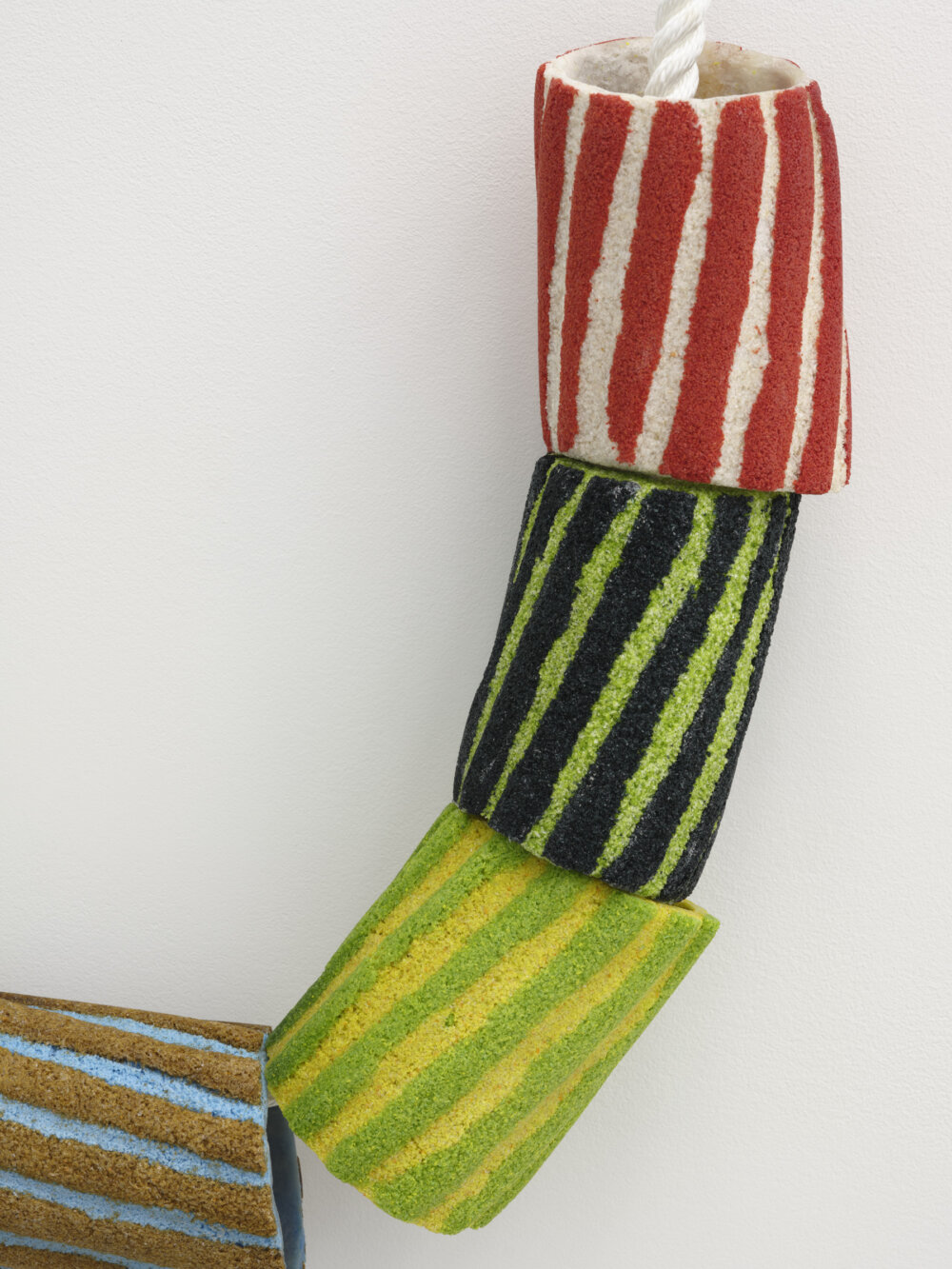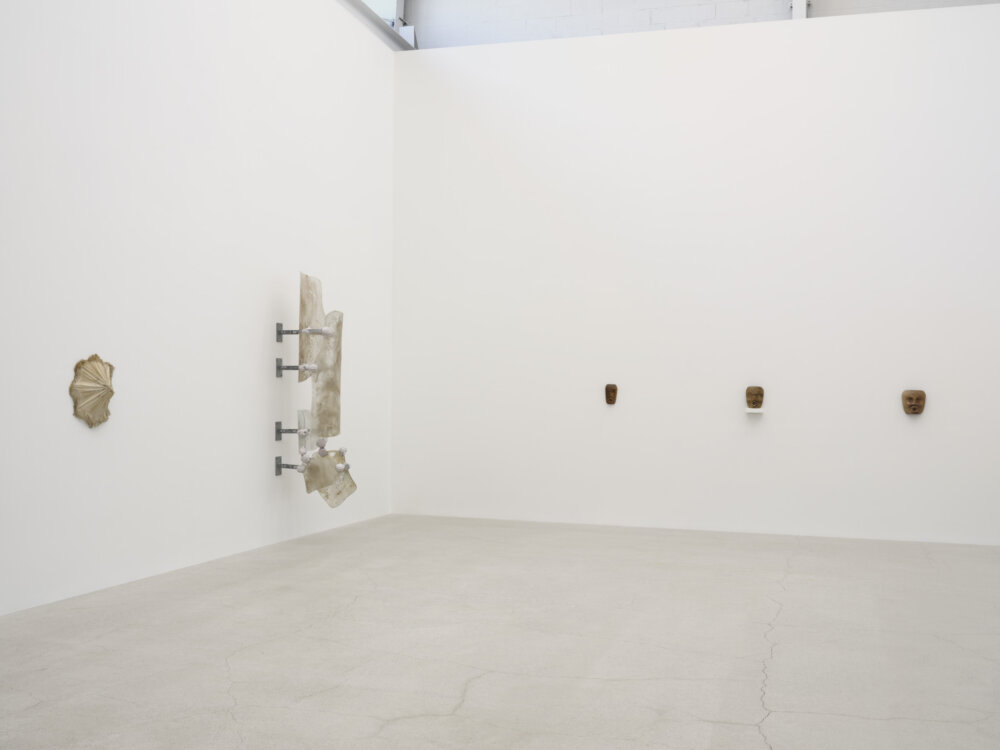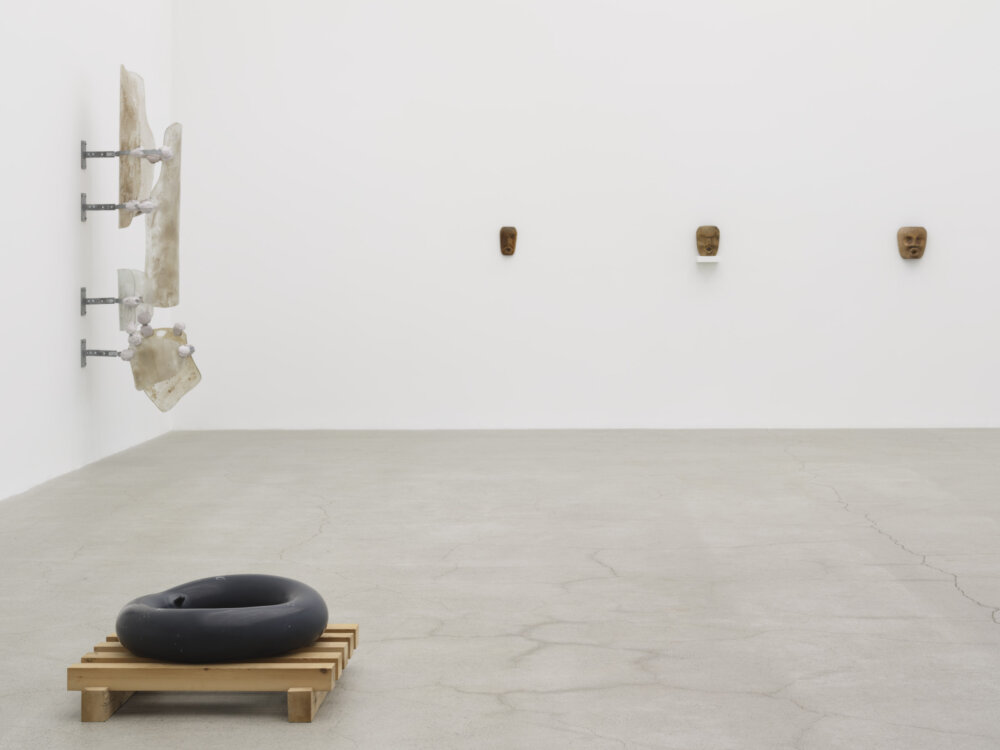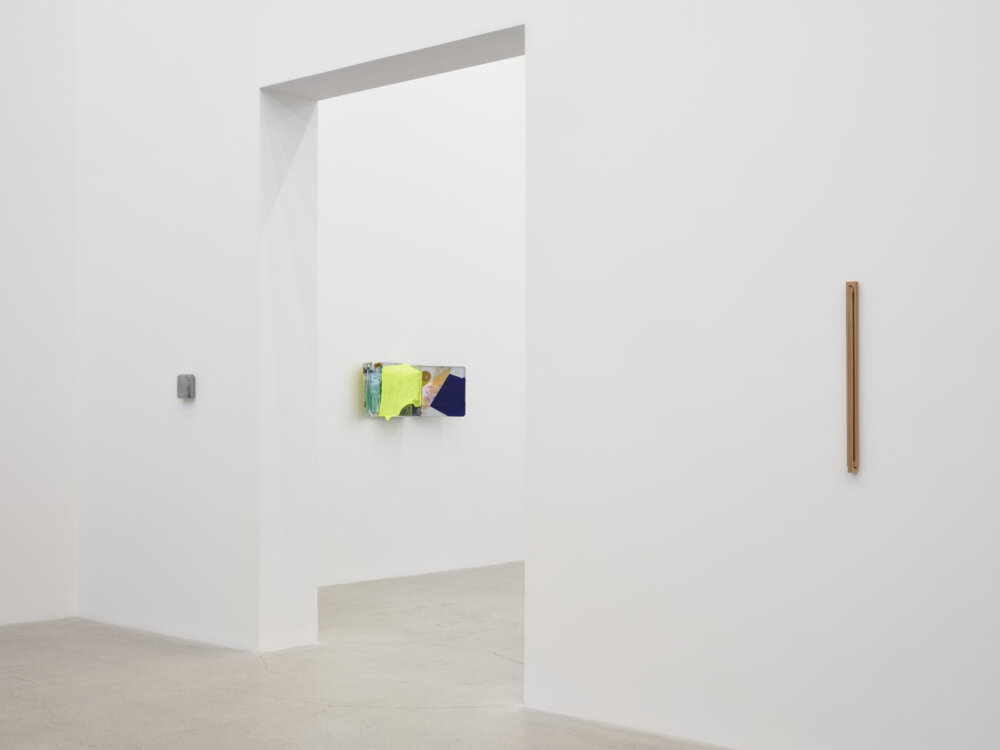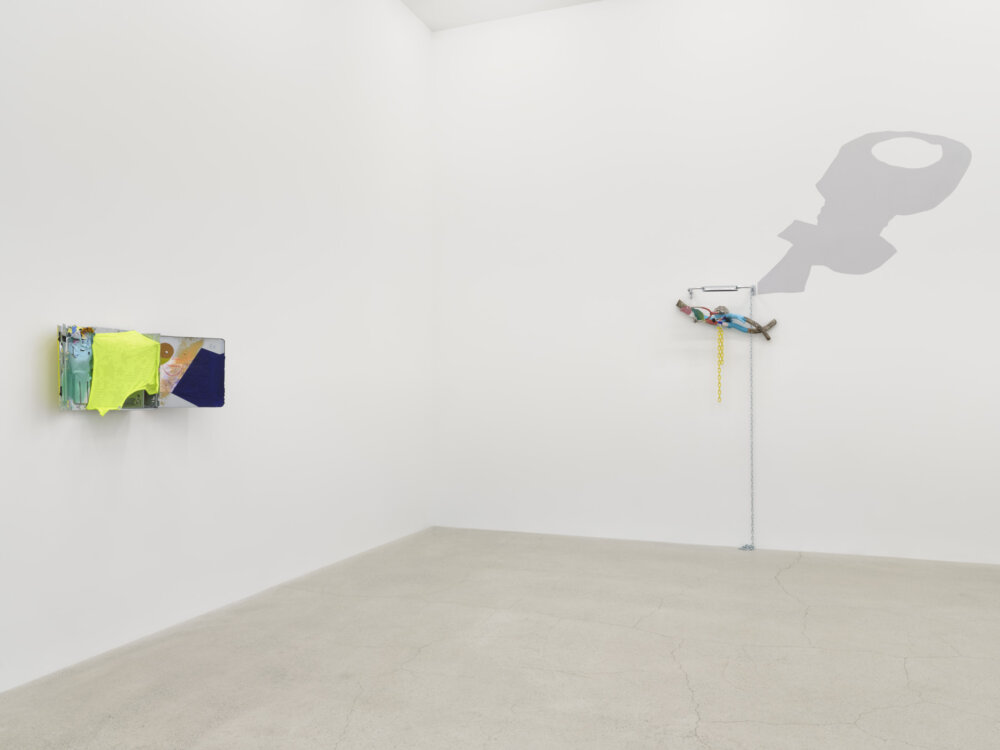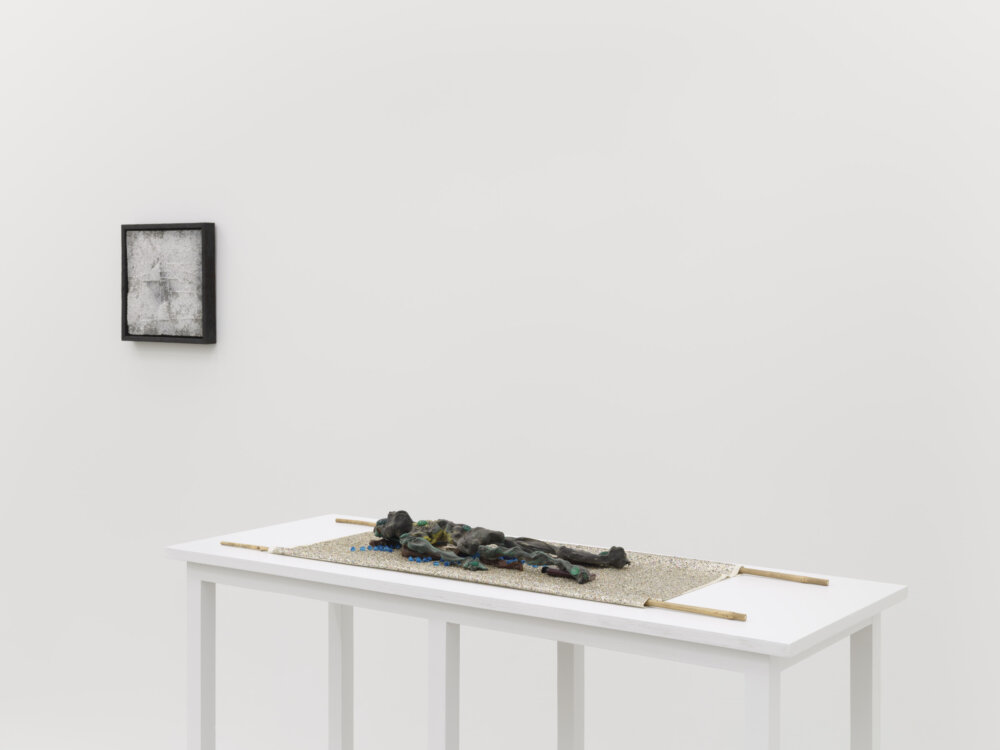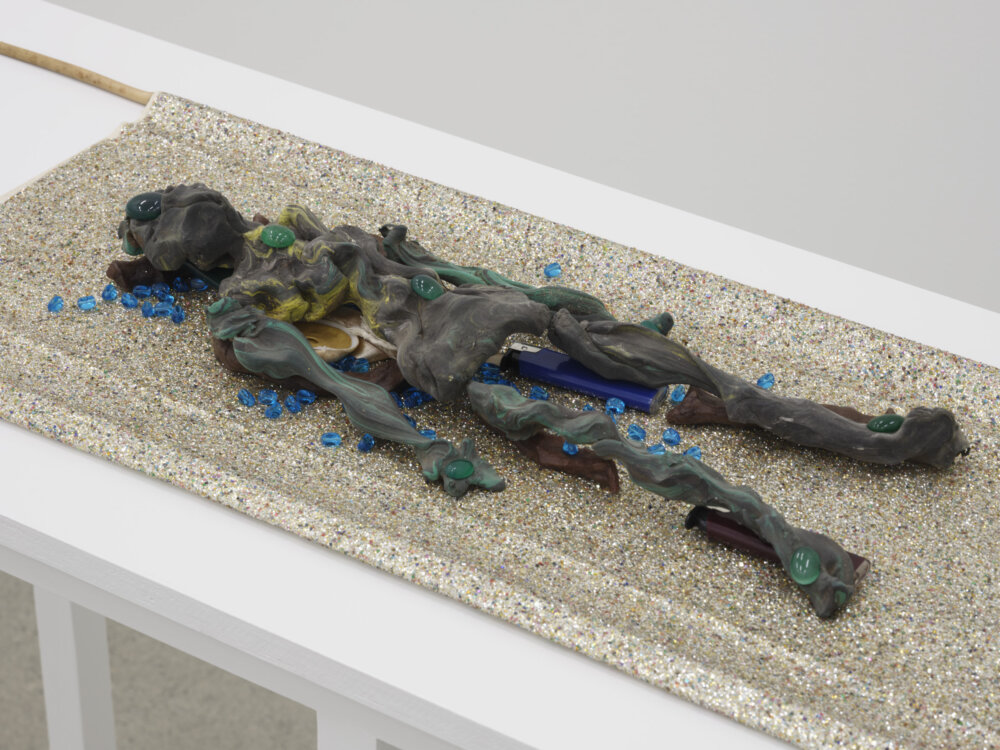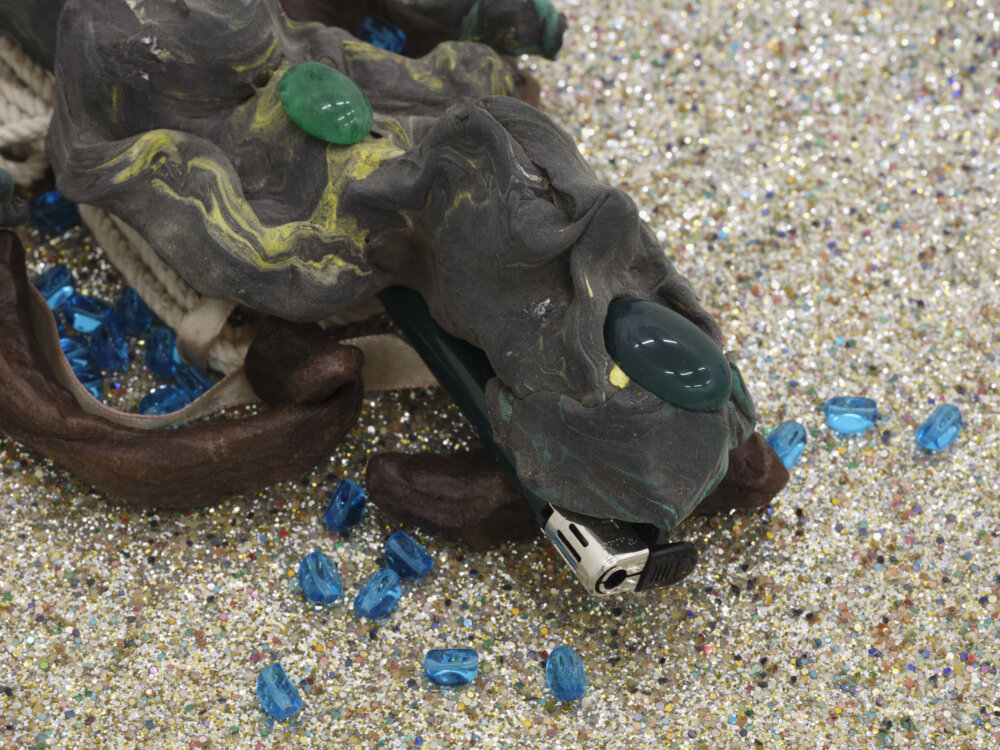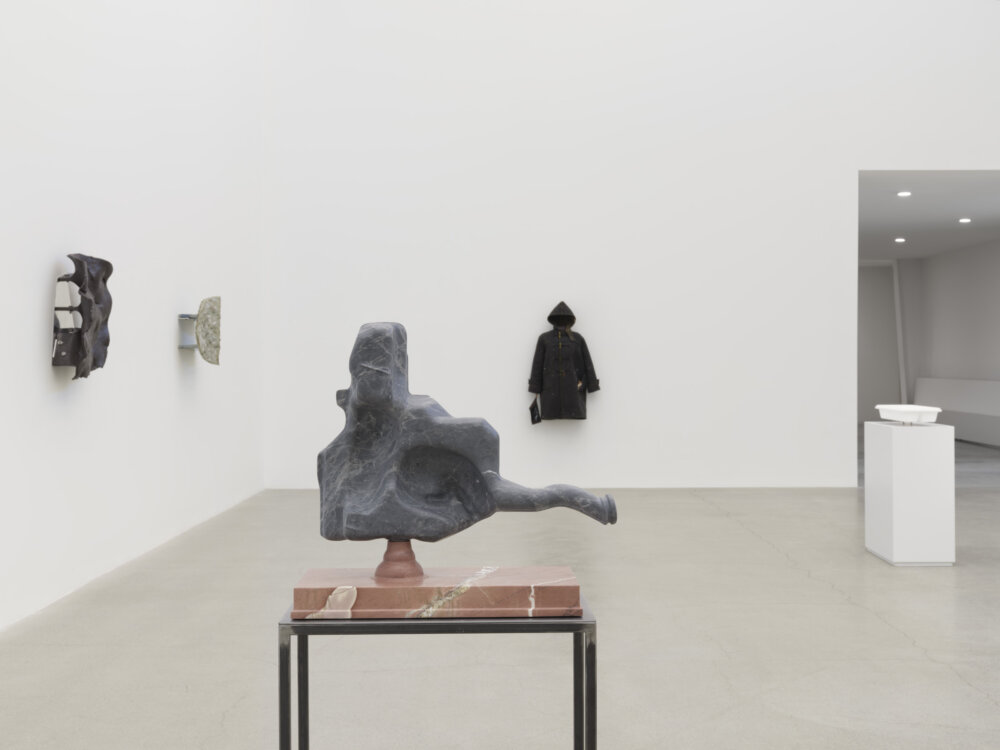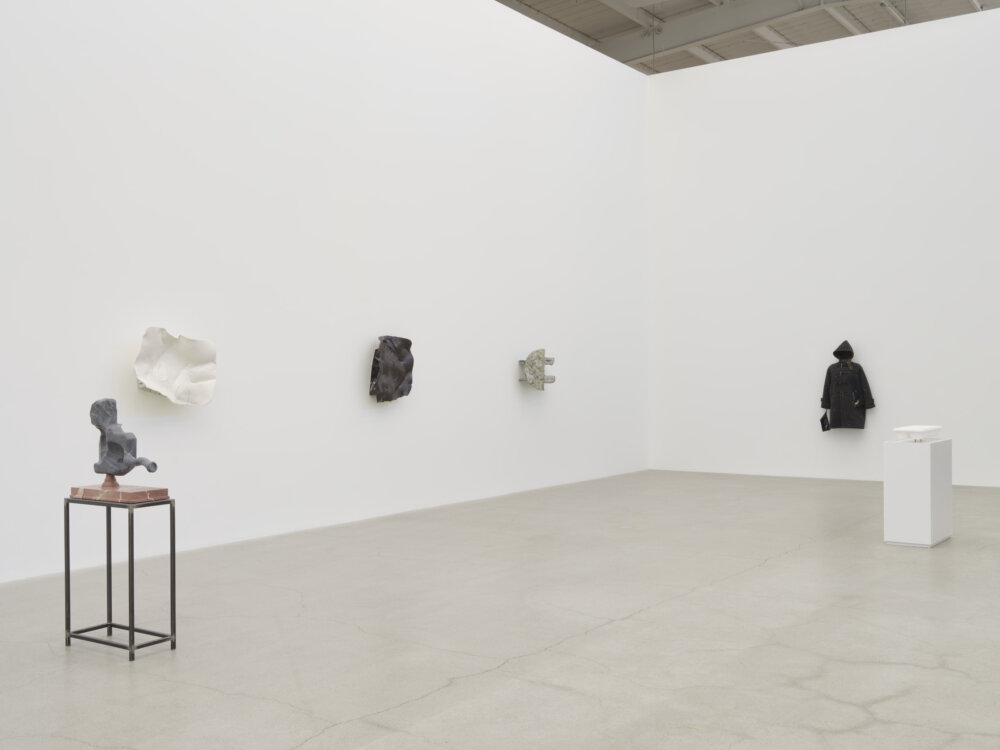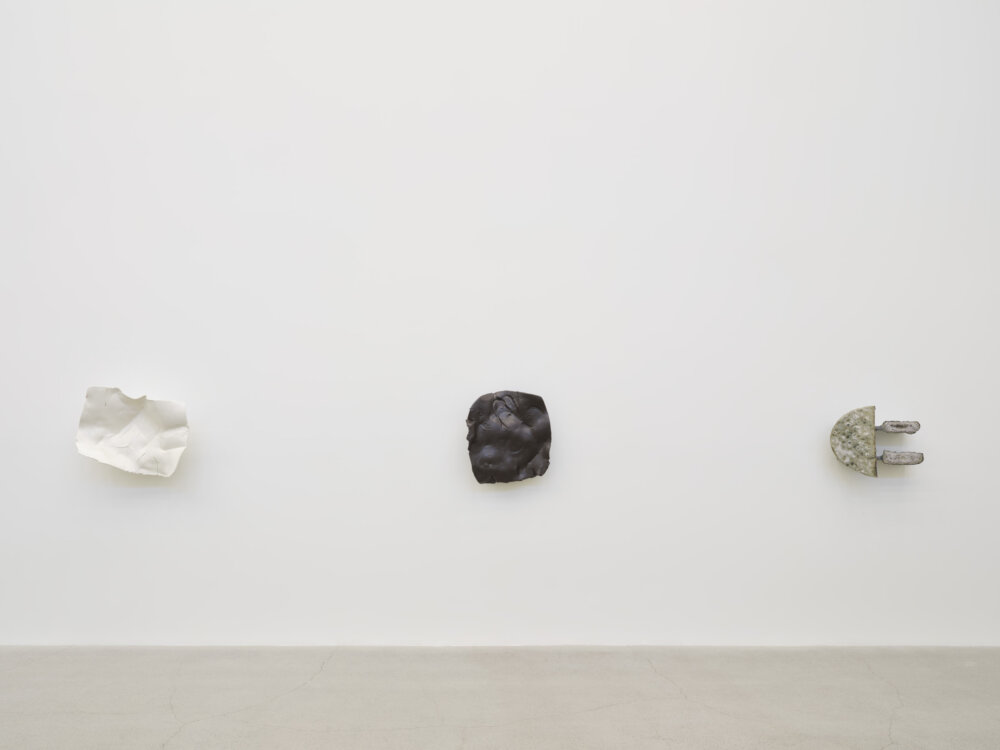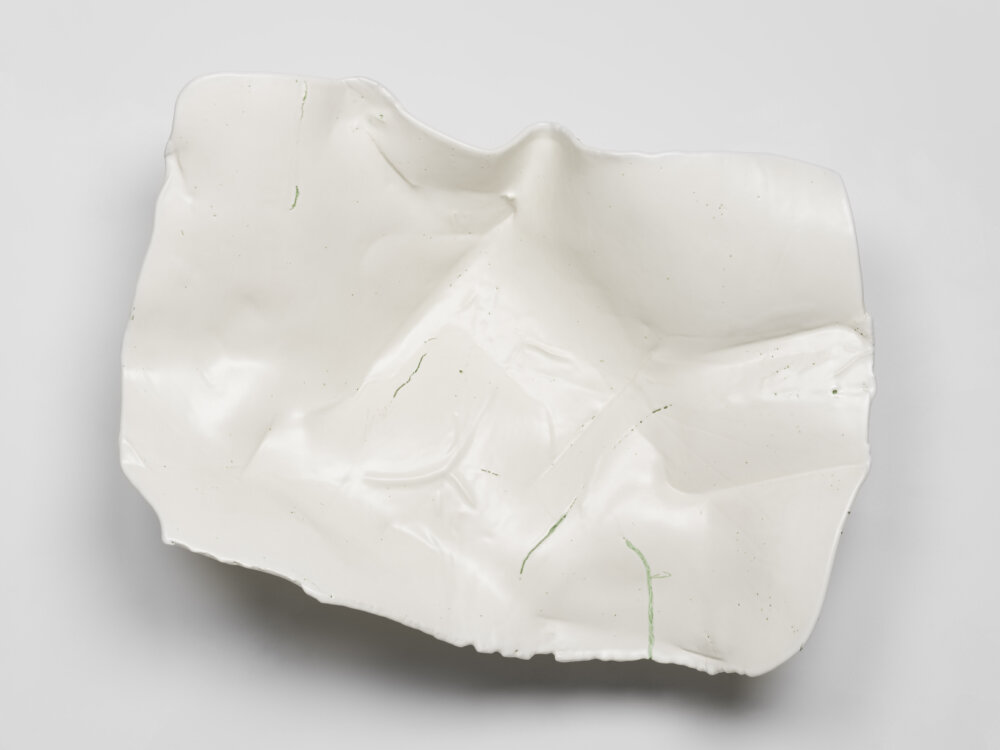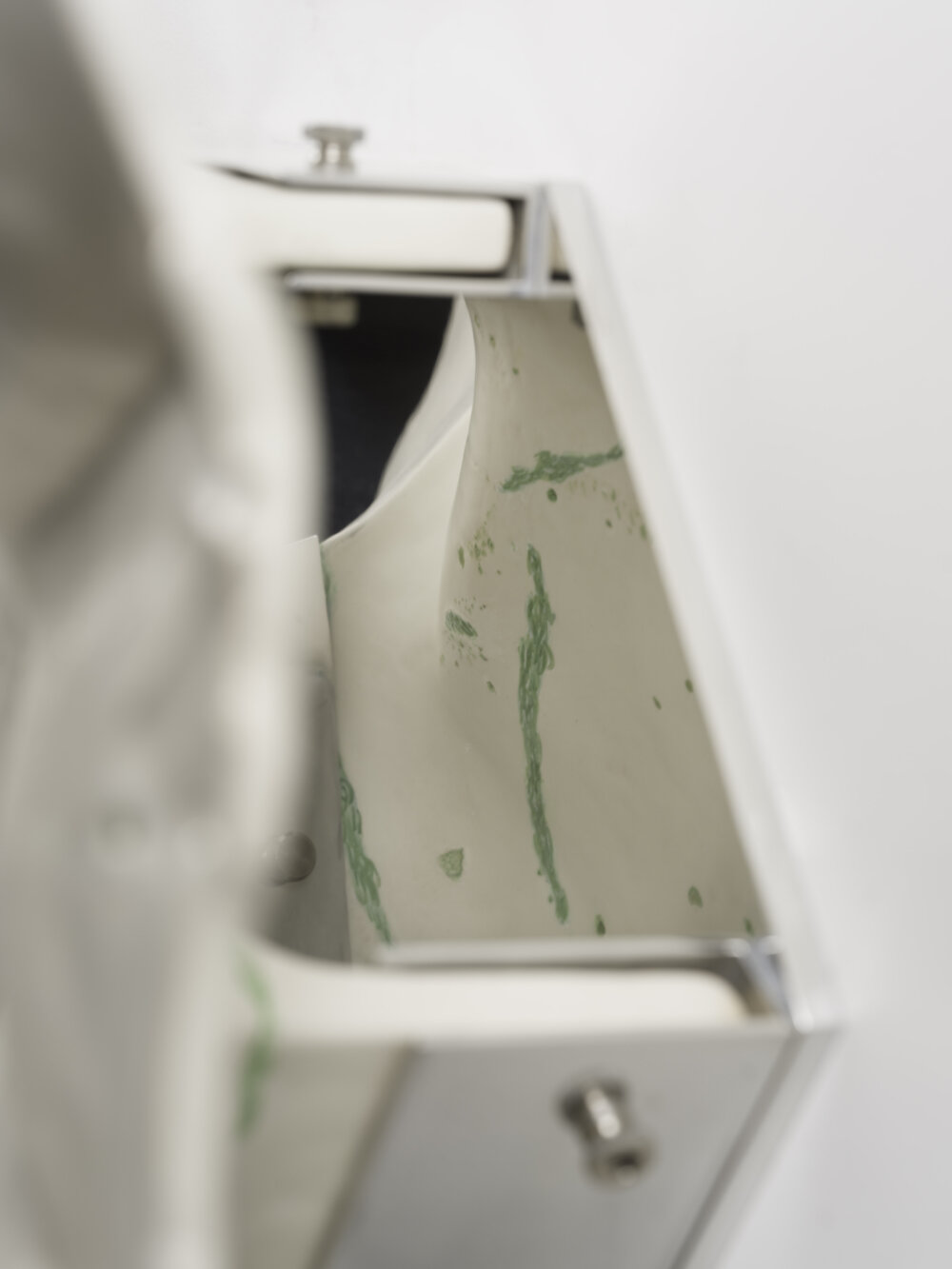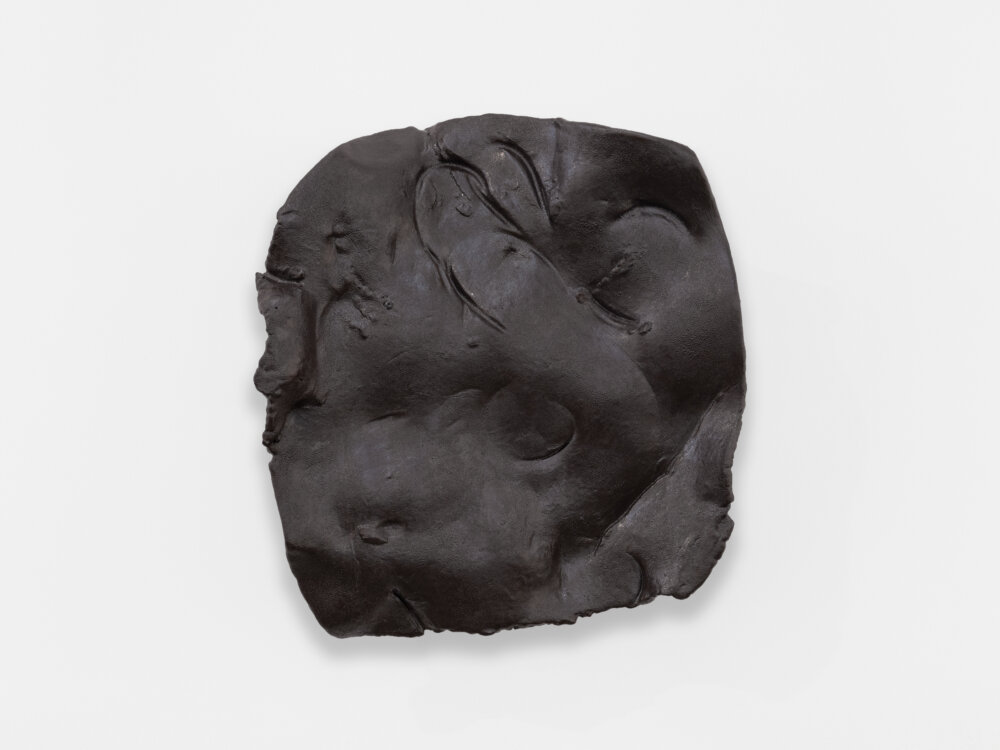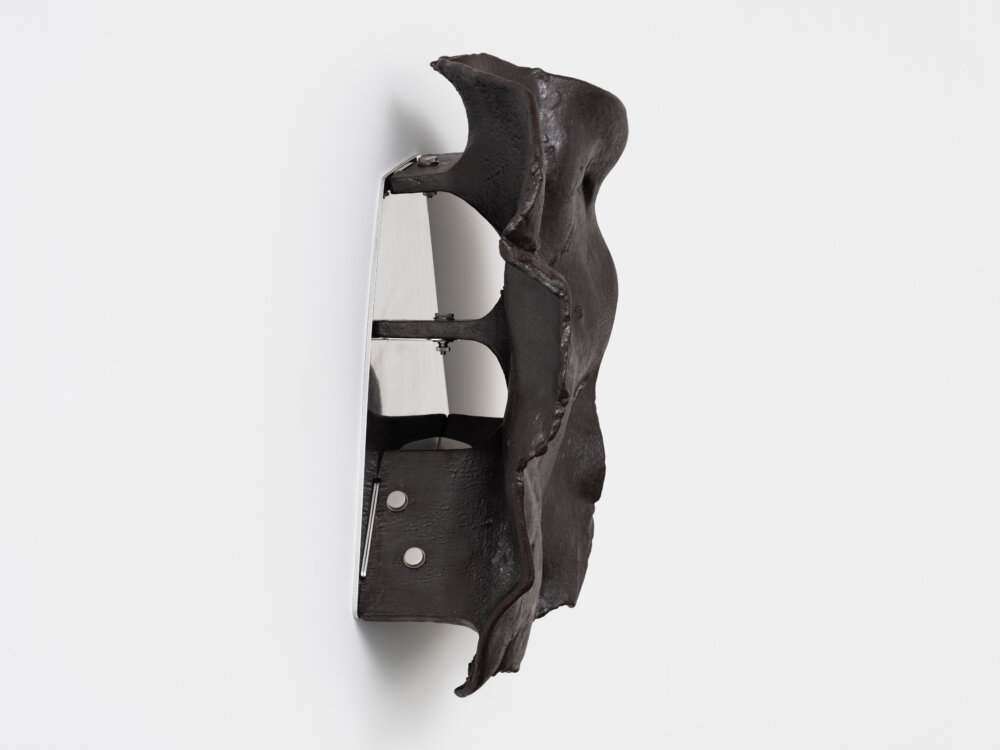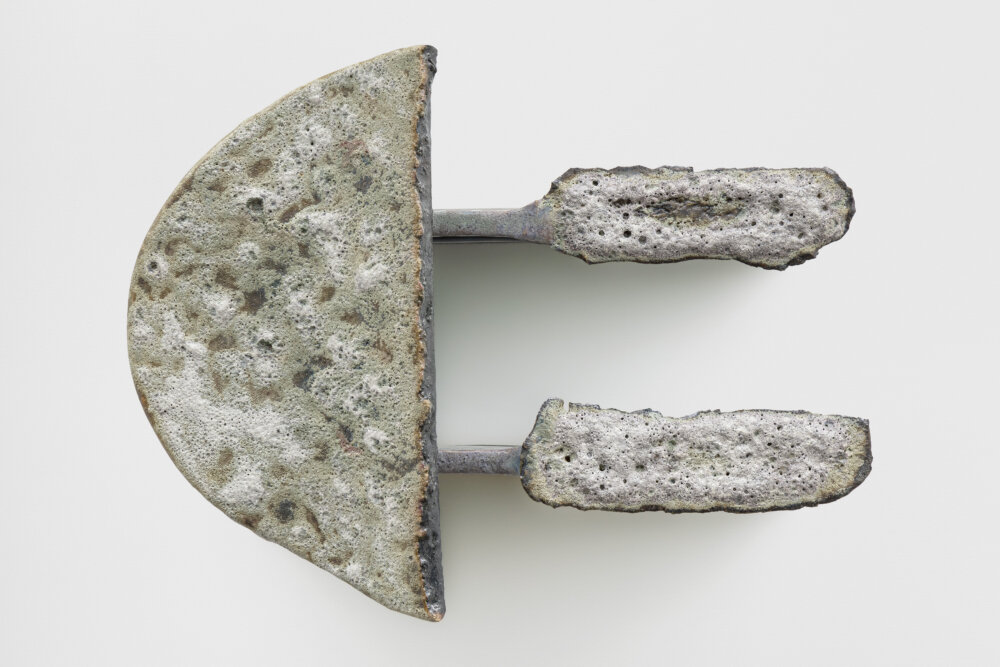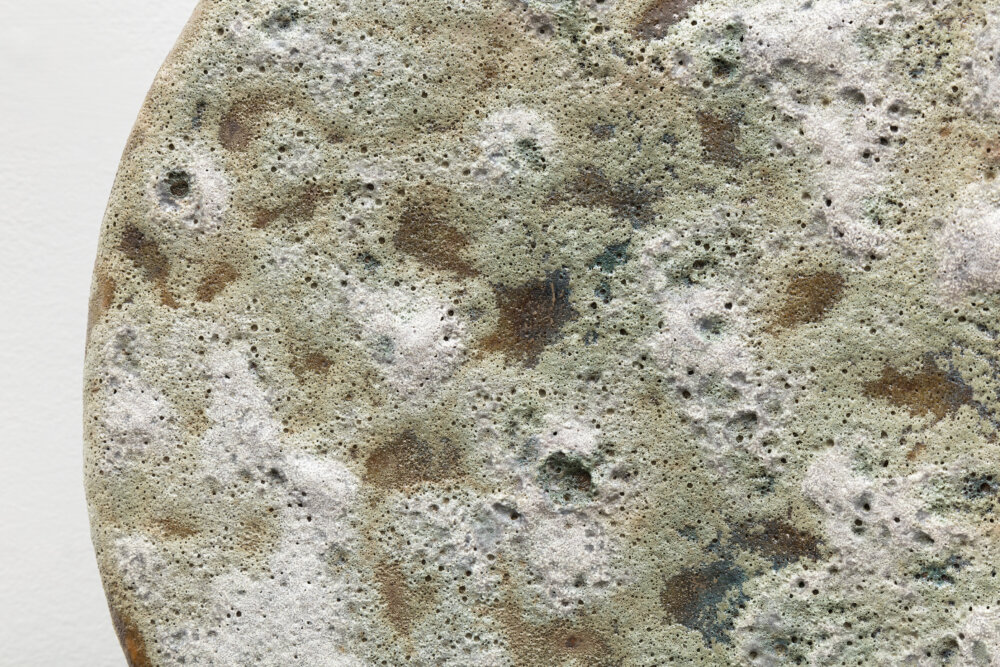Nairy Baghramian, Matt Browning, James Carl, Devon Knowles, Clémence de La Tour du Pin, Liz Larner, Christina Mackie, Liz Magor, Ellen Neel, Jessica Stockholder
Slow Looking
February 15–April 5, 2025
The term ‘slow looking’ has been adopted in museum culture as a pedagogical shortcut to encourage visitors to consider artwork beyond a statistically quick glance—a soft counter to the generalized, contemporary disregard for the specificities of art and art histories. This aligns with the current dominant desire and demand across culture for immediacy, asking for art to communicate instantly and that its authorship and attendant meanings circulate easily. Taking this context as a catalyst to consider works that resist and/or alter these prevailing modes, Slow Looking highlights discrete art objects that encourage a sustained unfolding of aesthetic experience. These works invite contemplation and provide us with encounters of beguiling opacity and abstraction, directing us to a more complex, mediated encounter.
Through the committed, sophisticated, and interconnected languages of material, form, production, and their related histories, the artists here simultaneously confound and expand our understanding of culture and the physical world. Nairy Baghramian and Liz Larner both develop direct and explicit connections between the seemingly fragile materials of glass, ceramic, and the hard gallery wall through custom metal mount and joint hardware. The vertical, bodily translucent forms by Baghramian prominently contrasts Larner’s opaque, textured, subtly coloured panels—their forms counteracting the physical reality of gravity—making the strange ever stranger.
Devon Knowles’ enigmatic wall sculptures merge historical and contemporary fabrication methods to produce aesthetically unpredictable forms. Here the artist has enlarged a child’s macaroni necklace and a stained glass panel through 3D scanning, printing, and finally articulated through ancient glass and aluminum casting methods—pushing her sculptures far beyond their referential origins as their new surfaces refract light. James Carl also employs classical and modern techniques in his laboriously carved vernacular forms: producing an alternate reality where scale, material, and detail sit closely alongside, but not identical to our own. A gleaming ice cube tray floats above its plinth—its white marble calcite sparkling and translucent—alongside a car engine fluid reservoir that balances elegantly upon a red marble mount usually reserved for historical busts. The subtle seam from the reservoir’s original plastic fabrication, now hewn in marble, along with its technological form speaks to the future, the present, and the past simultaneously.
Ellen Neel’s powerful raw cedarwood carvings also operate in this material–relation to time. In this series, Neel worked simultaneously against tradition in her unique process, while upholding her familial practices in both form and material. By carving the masks against the grain of wood rather than with it, as custom dictated, she adopted a much more difficult task to extraordinary effect: revealing the growth lines of the tree itself. The resulting undulating, topographic-like lines articulate time from natural occurrence, while creating a new formal conversation within a specific form.
Clémence de La Tour du Pin transforms umbrellas in varying stages of disintegration, found in a former aristocratic French home, into curiously organic and technological relics. Through attending to subtle details of their material deterioration, the artist mends the decay with 10 karat gold and ornate thread. In careful parallel, Liz Magor’s figureless duffle coat sculpture accentuates a past by highlighting and caring for its former use through small sewn additions, contrived moth holes, and cast cookies. Seemingly forming itself from random objects, Christina Mackie’s work features a small prone body laid upon a sparkling stretcher. Scraps of rope, child’s clay, gemstones, glass, and sea-life, all in varying colours of green correlated tones, coalesce briefly to render a just-present body.
In relation to this conglomeration of disparate materials, Jessica Stockholder’s colourful, elaborate compositions from our contemporary material flotsam and jetsam leverage the phenomenological and the chromatic with disposability and permanence simultaneously. We oscillate between the abstraction of total composition and the specificity of the forms with familiar origins. Matt Browning’s objects directly address their own material origins, economic life, and related production methods. Heat shrunk, plastic bottles are layered to create pillow-like, semi-translucent wall jewels, offset by Dr. Pepper soda which has been reduced into a crude oil-like viscous material. These minimalist transformations are punctuated by an interlocking wood grid hand-carved from a solid block in the tradition of “wood whimsies.”
It is through the richness of a slow encounter mediating the objects that the complexities and refinements of the works can identify and subvert our expectations. By considering what they are made of and how they are made, alongside the nuances of their visual and cultural languages and histories, the artworks themselves reveal how generous seemingly difficult objects can be. Slow Looking encourages the viewer to consider how the past informs our present, allowing us to engage, think abstractly, and perceive a world different.
–Peter Gazendam
Nairy Baghramian’s (b. 1971, Iran; lives/works: Berlin) work offers a reflection on the incessant cycle of aesthetic object production, cultivating an interest in marginalized art forms and spaces that are often considered territory of the “feminine.” Recent solo shows include her façade commission, Scratching the Back, at The Metropolitan Museum of Art, New York (2023), and those at Aspen Art Museum, Colorado (2023); Nasher Sculpture Center, Dallas, Texas (2022); Galleria d'Arte Moderna (GAM), Milan, Italy (2021); MUDAM Luxembourg, Luxembourg (2019); Palacio de Cristal, Madrid, Spain (2018); and the Walker Art Center, Minneapolis (2017).
Matt Browning’s (b. 1984, Redmond, WA; lives/works: New York) work concerns time, latency, and the selective and hierarchical valuation of human activity. Recent solo exhibitions include Sant’Andrea De Scaphis, Rome (2024); Essex Street, New York (2023); and Gandt, Queens (2022), with group exhibitions at the 15th Baltic Triennial, Vilnius, Lithuania (2024), MoMA PS1 (2024), Kunsthalle Zürich (2023); Galerie Buchholz, Cologne (2022); Kunstverein Nürnberg (2019); and the Vancouver Art Gallery (2016).
James Carl (b. 1960, Montreal; lives/works: Toronto) creates small and large-scale sculptures from a wide variety of materials, ranging from cardboard to cast bronze, and marble to Venetian blinds. Craft, material, labour, and art history provide the practical and conceptual frameworks for his work. Carl earned his MFA from Rutgers University and holds degrees from McGill University, the University of Victoria, and the Central Academy of Fine Art in Beijing. For twenty-two years, he served as a Professor of Studio Art at the University of Guelph. His work is held in public and private collections in North America, Europe, and China, including the National Gallery of Canada, the Art Gallery of Alberta, and the Art Gallery of Ontario.
Devon Knowles (b. 1977, London, ON; lives/works: Hamilton) has a material-centered practice in sculpture, installation, and public art in which the varied histories, economies, and social meanings of diverse matter and processes are unpredictably combined through both traditional and emergent fabrication methods. Her work has been included in exhibitions nationally and internationally including the Vancouver Art Gallery (2022); Or Gallery, Berlin (2014); Western Front, Vancouver (2013); SFU Galleries, Burnaby (2015); and Off-Lomas, Albuquerque (2015). She has received numerous public art commissions for both civic and private collections. Her work is represented by Equinox Gallery in Vancouver and she is an Assistant Professor of Sculpture at the University of Guelph.
Clémence de La Tour du Pin (b. 1986, Roanne, France; lives/works: Paris and New York) graduated from École Boulle, Paris (2008) and the School of Art, Architecture & Design, London Metropolitan University (2010). Her artistic practice comprises different mediums such as painting, assemblage, and olfactory media. Recent solo and duo exhibitions include Towards, Toronto (2024), Derosia, New York (2024); Wschód, Warsaw (2023); Tonus, Paris (2023); Smart Objects, Los Angeles (2021); Femtensesse, Oslo (2021); and 15 Orient at Balice Hertling, Paris (2020).
Since the 1980s, Liz Larner (b. 1960, Sacramento; lives/works: Bellingham, WA) has reimagined the possibilities of sculpture in plastic, bronze, fiberglass, paper, ceramic, aluminum, steel, rubber, epoxy, mirror, textiles, and even bacteria. By drawing from the refined and experimental vocabulary of minimal and postminimal precedents, Larner occasions fresh angles for this century on familiar questions of gender, the body, and the sustainability of life as we know it. Recent solo exhibitions include SculptureCenter, New York (2022); Walker Art Center, Minneapolis (2022); Kunsthalle Zürich (2022); Aspen Art Museum (2016); Art Institute Chicago (2015); and Kunsthaus Graz (2006).
Christina Mackie (b. 1956, Oxford, UK; lives/works: London, UK) trained as a painter, but over the past four decades she has undertaken an exploration of colour and perception through a range of media, including sculpture, watercolour, photography, ceramics, and found materials. Mackie's recent work centres on installations, borne out of her research into materials and forms which facilitate different forms of change, exchange, or transaction. Recent solo exhibitions include Hospitalfield, Angus, Scotland (2021); Catriona Jeffries, Vancouver (2019); Spazio Culturale Antonio Ratti, Como (2018); Tate Britain, London (2015); PRAXES, Berlin (2014); The Renaissance Society, Chicago (2014); Nottingham Castle (2013); and Chisenhale Gallery, London (2012).
Liz Magor (b. 1948, Winnipeg; lives/works: Vancouver) uses traditional mould-making techniques to replicate everyday objects either as discrete, uncanny forms, or spliced together with an unrelated quotidian object of her environment. Consistent throughout Magor’s practice is an experimentation with traditional sculptural elements such as mass, volume, and weight, mixed with a slightly sardonic humor. She has presented solo exhibitions at Museum of Contemporary Art, Toronto (2023); Focal Point Gallery, Southend-on-Sea, UK (2023); Douglas Hyde Gallery, Dublin, Ireland (2023); Andrew Kreps Gallery, New York (2021); Carpenter Center for the Arts, Cambridge (2019); Renaissance Society, Chicago (2019); Musée d’Art Moderne et d’Art Contemporain de Nice, France (2017); Kunstverein in Hamburg, Germany (2017); Musée d'art contemporain de Montréal (2016); and the Art Gallery of Ontario, Toronto (2015).
Ellen Neel (b. 1916, Kwakwaka'wakw from Alert Bay, BC; d. 1966, Vancouver) is recognized as one of the first renowned female Northwest Coast artists. Her carvings often featured iconic forms like the Thunderbird, globe motifs, human figures, and Dxunukwa (wild woman of the woods), which she used to convey stories of resilience, identity, and interconnectedness. By the 1940s, she established herself as a leading artist and entrepreneur, running the Totem Arts Studio with her family in Vancouver’s Stanley Park. Notable projects include the 16-foot Victory Through Honor pole gifted to the University of British Columbia in 1948 and the Totemland Pole design commissioned by the Totemland Society.
Jessica Stockholder’s (b. 1959, Seattle; lives/works Nanaimo, BC) extensive practice arises in relationship to the excessive expendability of physical materials within a capitalist or post-capitalist society. Her work finds beauty in complexity and contradiction, points to the intermingling of our invented world with the given, and reflects back to us the fascinating detritus of contemporary life. Recent solo exhibitions include the Carnegie Museum of Art, Pittsburgh (2024); Frac Normandie, Sotteville-lès-Rouen (2023); Kavi Gupta Gallery, Chicago (2021); 1301PE, Los Angeles (2020); The Contemporary Austin (2018); Galerie nächst St. Stephan, Vienna (2016); Smart Museum, Chicago (2015); and Frac des Pays de la Loire, Nantes (2012).
Documentation by Rachel Topham Photography.
Click here to read a conversation with artists Jessica Stockholder, James Carl, and Matt Browning.
Click here to read an exchange between artists Devon Knowles and Liz Larner.


